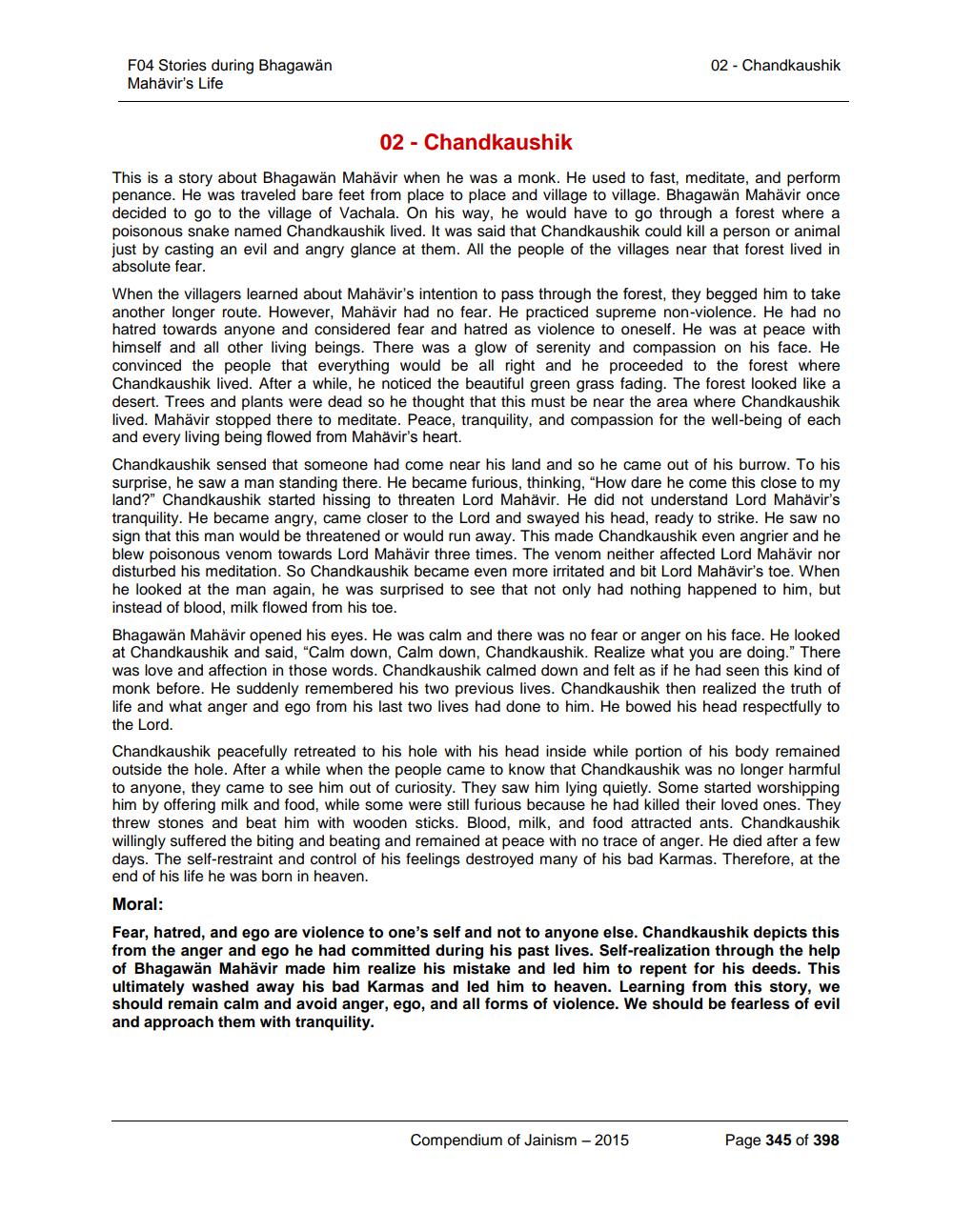________________
F04 Stories during Bhagawan Mahävir's Life
02 - Chandkaushik
02 - Chandkaushik
This is a story about Bhagawan Mahävir when he was a monk. He used to fast, meditate, and perform penance. He was traveled bare feet from place to place and village to village. Bhagawan Mahävir once decided to go to the village of Vachala. On his way, he would have to go through a forest where a poisonous snake named Chandkaushik lived. It was said that Chandkaushik could kill a person or animal just by casting an evil and angry glance at them. All the people of the villages near that forest lived in absolute fear. When the villagers learned about Mahävir's intention to pass through the forest, they begged him to take another longer route. However, Mahävir had no fear. He practiced supreme non-violence. He had no hatred towards anyone and considered fear and hatred as violence to oneself. He was at peace with himself and all other living beings. There was a glow of serenity and compassion on his face. He convinced the people that everything would be all right and he proceeded to the forest where Chandkaushik lived. After a while, he noticed the beautiful green grass fading. The forest looked like a desert. Trees and plants were dead so he thought that this must be near the area where Chandkaushik lived. Mahävir stopped there to meditate. Peace, tranquility, and compassion for the well-being of each and every living being flowed from Mahävir's heart. Chandkaushik sensed that someone had come near his land and so he came out of his burrow. To his surprise, he saw a man standing there. He became furious, thinking, "How dare he come this close to my land?" Chandkaushik started hissing to threaten Lord Mahävir. He did not understand Lord Mahävir's tranquility. He became angry, came closer to the Lord and swayed his head, ready to strike. He saw no sign that this man would be threatened or would run away. This made Chandkaushik even angrier and he blew poisonous venom towards Lord Mahavir three times. The venom neither affected Lord Mahävir nor disturbed his meditation. So Chandkaushik became even more irritated and bit Lord Mahävir's toe. When he looked at the man again, he was surprised to see that not only had nothing happened to him, but instead of blood, milk flowed from his toe. Bhagawan Mahävir opened his eyes. He was calm and there was no fear or anger on his face. He looked at Chandkaushik and said, "Calm down, Calm down, Chandkaushik. Realize what you are doing." There was love and affection in those words. Chandkaushik calmed down and felt as if he had seen this kind of monk before. He suddenly remembered his two previous lives. Chandkaushik then realized the truth of life and what anger and ego from his last two lives had done to him. He bowed his head respectfully to the Lord. Chandkaushik peacefully retreated to his hole with his head inside while portion of his body remained outside the hole. After a while when the people came to know that Chandkaushik was no longer harmful to anyone, they came to see him out of curiosity. They saw him lying quietly. Some started worshipping him by offering milk and food, while some were still furious because he had killed their loved ones. They threw stones and beat him with wooden sticks. Blood, milk, and food attracted ants. Chandkaushik willingly suffered the biting and beating and remained at peace with no trace of anger. He died after a few days. The self-restraint and control of his feelings destroyed many of his bad karmas. Therefore, at the end of his life he was born in heaven. Moral: Fear, hatred, and ego are violence to one's self and not to anyone else. Chandkaushik depicts this from the anger and ego he had committed during his past lives. Self-realization through the help of Bhagawan Mahävir made him realize his mistake and led him to repent for his deeds. This ultimately washed away his bad karmas and led him to heaven. Learning from this story, we should remain calm and avoid anger, ego, and all forms of violence. We should be fearless of evil and approach them with tranquility.
Compendium of Jainism - 2015
Page 345 of 398




